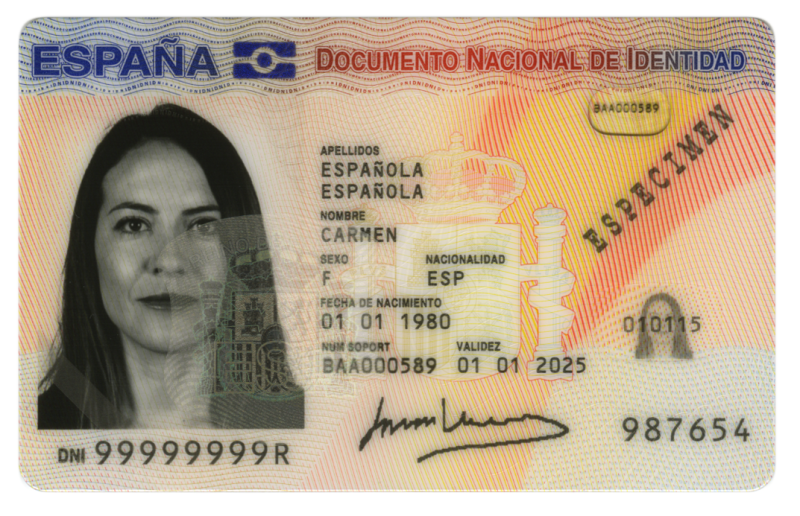The electronic ID
What is the Electronic ID?
The electronic ID is a document issued by the Police Directorate-General (Ministry of the Interior). In addition to physically certifying the personal identity of the owner, it allows:
- Certify electronically and unequivocally their identity.
- Sign digitally electronic documents, giving them a legal validity equivalent to that provided by the handwritten signature.
The DNIe incorporates a small integrated circuit (chip), containing the same data as printed on the card (personal data, photograph, digitised signature and digitised fingerprint) together with the Authentication certificates and of Electronic Signature.
In this way, anyone will be able to make multiple online efforts securely with the public administrations, with public and private companies, and with other citizens, at any time and without having to move or queue.
Electronic Certificates in the DNIe
With the electronic ID, two certificates are obtained:
- Authentication Certificate: Electronically guarantees the identity of the citizen when performing a telematics transaction. This Certificate ensures that electronic communication is done with the person it says it is, with the identity certificate and the private key associated with it.
- Certificate of Signature: Allows the signature of formalities or documents, replacing the handwritten signature. It therefore guarantees the identity of the subscriber and holder of the private identification and signature key.
For more information about What is the electronic ID visit the page of the National Police Force or Basic Reference Guide of the electronic ID card.
You can learn more about certificates in the Electronic Certificates section.
The electronic certificate

The basic process for electronic signatures is as follows:
- The user has an electronic document (a spreadsheet, a pdf, an image, even a form on a website) and a certificate that belongs to him and identifies him.
- The application or digital device used for the signature summarises the document. The summary of a large document can be just a few lines. This summary is unique and any amendment to the document also implies a modification of the summary.
- The application uses the private key to codify the summary.
- The application creates another electronic document containing that codified summary. This new document is the electronic signature.
The result of this whole process is an electronic document obtained from the original document and from the signatory's keys. The electronic signature, therefore, is the same resulting electronic document.
Remember:
The electronic signature is the resulting electronic file or document. This is the document that is valid for legal purposes and the one that you must keep. Any printing or graphic representation made of it is valid only in terms determined by the recipient of the signature. In general, in this case, the printed signature will contain a CSV or Safe Verification Code that allows the printed copy to be contrasted with the electronic original.
How to use the DNIe?
Technical Requirements
For the use of the ID card, it is necessary to have certain hardware and software elements that will allow us access to the card chip and, therefore, the use of the certificates contained in it.
While the DNIe only allows contact access, the DNI 3.0 has a dual interface chip, which also allows wireless connection via the NFC antenna.
For contact use you need:
- A personal computer.
- A smart card reader. There are different implementations, either integrated on the keyboard, either external (connected via USB) or via a PCMCIA card.
For contactless use, you need an NFC device that complies with ISO 14443, type A or B, as DNI 3.0 is compatible with both ISO 14443 standard implementations. This device can be a smartphone, tablet or NFC reader.
As far as software is concerned, the electronic ID is compatible with existing operating systems as well as with different browsers. Here you can get more information.
Technical requirements: Cryptographic Drivers / Modules In order to be able to interact properly with cryptographic cards and electronic ID, your computer must have installed some ‘pieces’ of software called cryptographic modules.
In an environment Microsoft Windows, the equipment must have a service that is called "Cryptographic ServiceProvider" (CSP) installed.
In settings UNIX / Linux or MAC DNIe can be used through a cryptographic module called PKCS#11.
On the eID website, in the section Download Area you can find the information to install the DNI both on Windows systems and on Linux and MacOs computers.
Renewal of the DNIe and Certificates
- Renewal of the DNIe. The renewal shall be carried out by the physical presence of the holder, who shall pay the fee and provide the relevant documents. The ID must be renewed within the last 90 days in force.
- Renewal of certificates. Certificates can be renewed over a period of time from 30 days before from the expiry date of the certificates until the expiry date of the physical medium (DNIe Card).
To renew your DNIe: According to Law 59/2003 of Electronic Signature if more than 5 years have passed since the first identification, the renewal, through the Update Points of the DNIe, will require the prior personation of the citizen to an official of the Dispatch Office.
The validity of the certificates contained on the card chip Electronic ID is 30 months. (Article 12. Validity of electronic certificates, RD 1553/2005 of 23 December)
Denunciation and revocation of certificates
In case of loss or subtraction of E-ID is mandatory personalise in an ID Dispatch Office to report the loss.
The Marketing Authorisation Holder and Manufacturer revocation the electronic certificates of your DNIe will be carried out by immediate form the processing of each application verified as valid.
